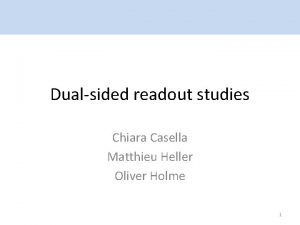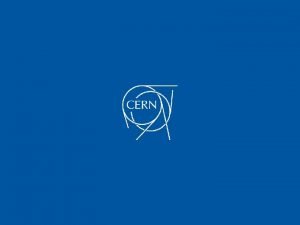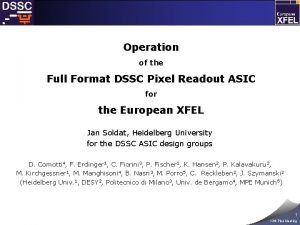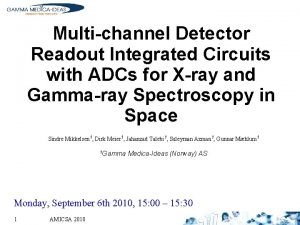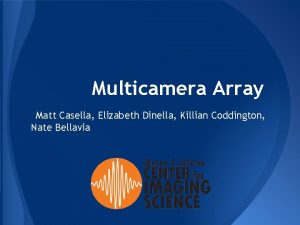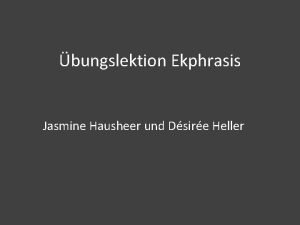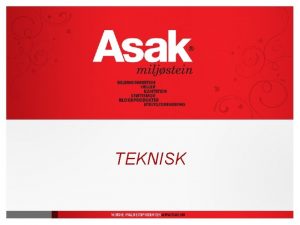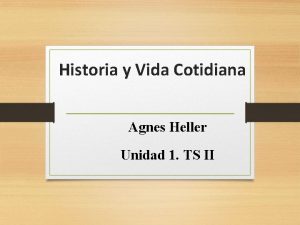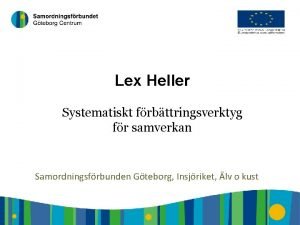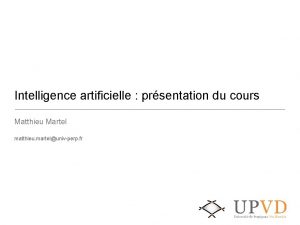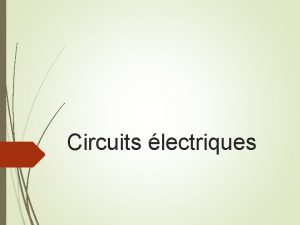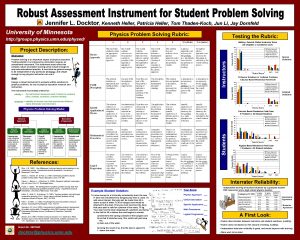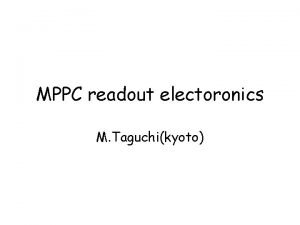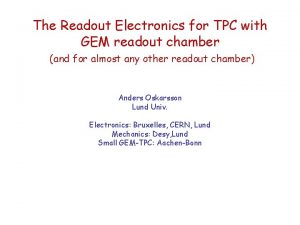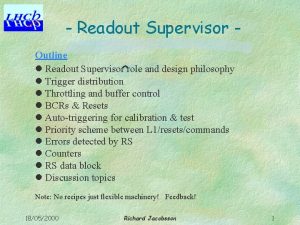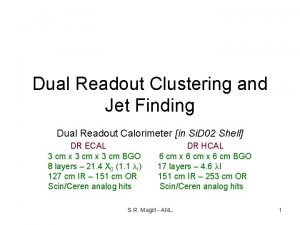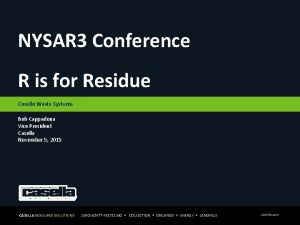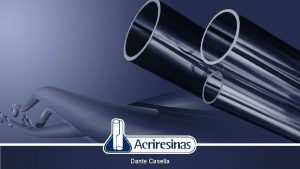Dualsided readout studies Chiara Casella Matthieu Heller Oliver


























- Slides: 26

Dual-sided readout studies Chiara Casella Matthieu Heller Oliver Holme 1

Dual-sided readout studies • Difference in Left and Right light yield is used to estimate gamma interaction position along z axis L R z-axis 0 • Original AXPET concept was based on dual-sided readout – Initial studies showed insufficient z-axis resolution (~cm) – New results from A. Goertzen indicated better z resolution (~3. 5 mm) • Investigation started to find best achievable resolution – Following A. Goertzen method – Using digital Si. PM for a compact axial module 2

Laboratory setup • Philips digital Si. PM tiles – L, R and Tagger – L and R tiles are cooled to ~14˚C to reduce dark count • Only events with 3 tile coincidence are stored – Acts to collimate a beam of gamma photons • Automated data taking with Philips and Lab. VIEW software – Scans through several position along z-axis 3

Crystal scanning • 3 x 3 x 100 mm LYSO crystals • Crystal aligned with one Si. PM pixel – All other cells were inhibited • Typical scan properties – 11 data taking runs at different positions along z axis • Typical run properties – ~15 minutes (with 3. 7 MBq source) – Up to 9000 events stored to file – Up to 1300 events after photopeak cuts 4

Data processing for each z position • Data from Si. PMs is converted to ROOT files • Light yield is processed: – – Cut on photopeaks (all three tiles) Correct for Si. PM cell saturation Correct for Si. PM intra-tile cross talk Obtain photopeak central values Raw data Gaussian fit Corrected data 5

Data processing for complete scan (R-L)/(R+L) • (R-L)/(R+L) Error bars show σ of (R-L)/(R+L) z position [mm] 6

Data processing for complete scan (R-L)/(R+L) • Error bars show σ of (R-L)/(R+L) FWHM Rz FWHM Position [mm] 7

Crystals and surface treatments • Coatings/wrappings: – – Bare White Ti. O 2 paint Teflon (2 layers) Enhance Specular Reflector (ESR) • Surface treatments (one or multiple faces): – Polished (from manufacturer) – Depolished (with ~10 µm powder) – Machined strips (with CNC diamond tool) 8

Machined strips • Two patterns of machined strips – Every 5 mm, aligned on four faces – Every 5 mm, staggered by 1. 25 mm on four faces Machined strips are ~0. 7 mm wide 9

Results 10

Non-exponential LY versus z • Crystals with less attenuation – LY versus z is not exponential • Crystals with greater attenuation – LY versus z is more similar to exponential Polished, teflon wrapped Two faces depolished, teflon wrapped 11

Inter-tile cross talk • Si. PMs have cross talk between cells in a tile – Intra-cell cross talk – Caused by avalanches producing secondary photons • The secondary photons are emitted isotropically – They can also enter and propagate through the crystal – Inter-tile cross talk • Inter-tile cross talk reduces L & R difference – Degrades z resolution • This degradation can be measured by capturing L and R tiles independently, with the other tile off – Not possible in real applications – Physically filtering the cross talk photons might be possible 12

Photopeak shifting Machined strips, 5 mm (aligned), teflon wrapped RIGHT SUM z-axis LEFT 13

Light yields and energy resolution Machined strips, 5 mm (aligned), teflon wrapped 14

z resolution Machined strips, 5 mm (aligned), teflon wrapped 15

Different surface treatments • Resolution down to ~3 mm has been achieved – Treatments give different energy resolutions due to different LY sum Energy resolution [%] Energy resolution Polished + Ti. O 2 paint Machined strips (four faces, aligned) + ESR Depolishing (two faces) + ESR 16

Machined strips • Fine scans reveal discrete structure – Gives stepped LY pattern – Seen in LY sum and energy resolution too Staggered strips, light yield - RIGHT Fitted photopeak position [pe] Aligned strips, light yield - RIGHT Position [mm] Staggered strips give a pseudo-continuous behaviour Position [mm] 17

Depolishing One face depolished + ESR Two faces depolished + ESR 18

Wrappings Four faced machined strips (aligned) Light yield - LEFT Light yield - RIGHT z [mm] Light yield - SUM ESR wrapped Teflon wrapped Unwrapped λeff ≈ 70 mm λeff ≈ 40 mm λeff ≈ 28 mm ESR gives almost constant LY SUM z [mm] 19

Wrappings Four faced machined strips (aligned) Teflon and ESR give similar resolution ESR gives more linear z position estimator ESR gives more light to improve resolution further 20

Results summary Wrapping/ Coating Rz FWHM at mid-point (mm) Energy resolution at mid-point (%) Polished Bare 52 8 Polished Teflon 22 8 Polished ESR 37 7 Polished Ti. O 2 paint 3. 1 15 Depolished (1 face) Bare 5. 8 18 Depolished (1 face) Teflon 4. 4 12 Depolished (1 face) ESR 4. 9 8 Depolished (2 faces) Teflon 3. 4 16 Depolished (2 faces) ESR 3. 7 11 Machined strips (aligned) Bare 3. 6 21 Machined strips (aligned) Teflon 2. 6 12 Machined strips (aligned) ESR 3. 2 8 Machined strips (staggered) Teflon 3. 1 12 Machined strips (staggered) ESR 3. 8 7 Crystal surface A crystal with better Rz at z=50 mm is not necessarily better at other z positions 21

Next steps and outlook • Improve results for 100 mm crystals – Extend machined strips to full crystal length – Depolish more faces • Shorter 60 mm crystals – Could achieve resolution down to 2 mm – Attenuation per mm would need to be increased • Photodetectors with higher PDE ? – Greater light yield would enable better resolution – Current Si. PM PDE is about 40% 22

23

Toy Monte Carlo results • Measured results are consistent with Toy MC – Estimated ~3 mm as best achievable resolution – Can indicate future possibilities λeff (mm) Crystal Length (mm) Max LY Rz at mid-point FWHM (mm) 33 100 1500 3. 03 33 100 3000 2. 14 33 60 1500 2. 27 20 60 1500 1. 85 10 60 1500 1. 99 20 60 3000 1. 32 7 20 1500 0. 70 7 20 3000 0. 53 Increased LY improves resolution 60 mm crystals would enable improvement down to 2 mm with current light yields 20 mm crystal figures match other published studies 24

Machined strips width 25

Depolished (one face) 26
 Matthieu heller
Matthieu heller Readout units
Readout units What is the principle of spectrophotometry
What is the principle of spectrophotometry Full pixel readout
Full pixel readout Readout integrated circuit
Readout integrated circuit Istituto casella pedara
Istituto casella pedara Icantonazzo
Icantonazzo Matthew casella
Matthew casella Giulio casella
Giulio casella Verfassunglehre
Verfassunglehre Craig heller
Craig heller Greyheller mobile
Greyheller mobile Katherine heller duke
Katherine heller duke Heller myotomy
Heller myotomy Desiree heller
Desiree heller David sadava
David sadava Kantsikring belegningsstein
Kantsikring belegningsstein Léo heller
Léo heller Heller zsolt
Heller zsolt Ultrageneralizacion heller
Ultrageneralizacion heller Noah heller
Noah heller Heller h 4000
Heller h 4000 Heller fundraising group
Heller fundraising group Lex rogata
Lex rogata Annette heller
Annette heller Paradigm shift from women studies to gender studies
Paradigm shift from women studies to gender studies Matthieu 13 44
Matthieu 13 44
